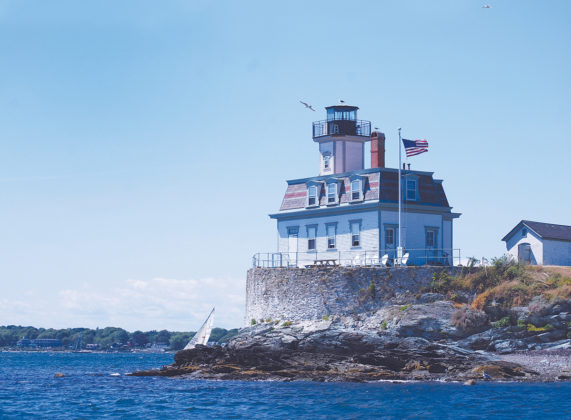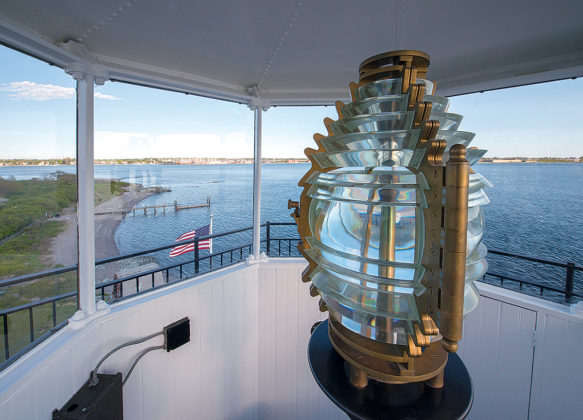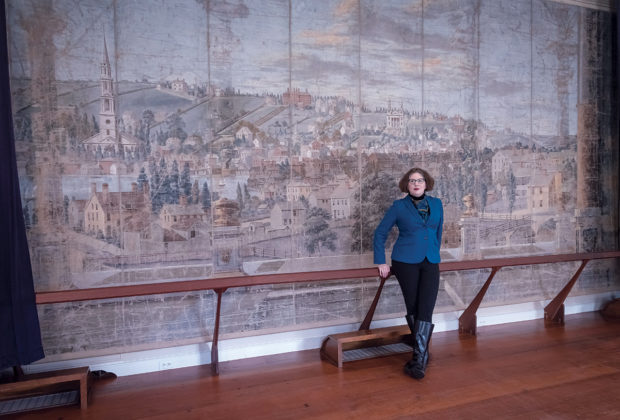
More than 190 Rhode Island-based historical and heritage organizations call the smallest state in the union home, according to a 2013 count by the R.I. Historical Society. That’s one for every 5½ square miles.
These nonprofits run the gamut, from the nationally known Preservation Society of Newport County that oversees the City by the Sea’s famous mansions, to the decidedly more locally focused, such as the American-French Genealogical Society in Woonsocket and Warren’s Massasoit Historical Association, which dates to a 1907 dedication of the Massasoit Spring.
For some of the smallest, “Their very existence and contact information [are] unknown except to a handful of people,” according to the 2013 historical society report.
There’s little mystery to why one of the nation’s original 13 colonies would have such a deep appreciation for local history, says Ted Sanderson, the state’s historic-preservation officer and executive director of the R.I. Historical Preservation & Heritage Commission.
“People care about preserving state heritage and historic places, but organize around the ones in their neighborhood or town,” he said. “Rhode Island has more historic properties to its size than any state in the country.”
Less clear, however, is how long many of the groups dedicated to preserving that history can continue to survive in an increasingly competitive fundraising landscape.
Consolidation might increase the staffing and fundraising power for some of the most challenged, but would require the kind of changes in operation or focus that have traditionally met resistance in parochial Rhode Island.
Characterizing the preservation groups as typically “busy and often short-staffed,” RIHS Executive Director C. Morgan Grefe said the greatest challenge to collaboration is lack of time and difficulty identifying material that suits both audiences.
“It makes sense for us to join forces … and give our audience more bang for their buck,” she said, but the challenge is “not to overwhelm a limited audience pool.
“Different organizations exist for different reasons,” she continued. “We would be remiss if we thought they only existed for public programming.”
‘PASSIONATE LOCALISM’
Much of Rhode Island’s historical preservation is tied to the state’s rich Colonial and Native American history. The state also played a key role in the American Industrial Revolution that began in the 18th century.
Immigrants that flooded into the state and region in the 18th- and early-19th centuries also contributed to the state’s diverse historical-preservation efforts due to “local differences and variation in demographics” that remain today, according to Grefe.
“People identified themselves very locally and continue to define their history and heritage locally,” she said.
Sanderson believes a “passionate localism” for their endeavors is a “critical element” in the creation of such organizations that both links and distinguishes them.
For example, he said, a “collaborative sense” exists in preservation work, but “the Preservation Society of Newport County and the Foster Preservation Society probably don’t have too much in common.”
But the passion that drives the creation of many local preservation groups may also hinder their prospects for long-term survival.
“In the nonprofit sector, intense local pride and a powerful sense of individual independence have hampered the creation of networks and other collaborative efforts,” according to the 2013 RIHS report.
The Rhode Island History Online Directory Initiative, or RHODI.org, that was part of the report measured the number of organizations open to the public and focused on Rhode Island history. The goal was to create a master list of existing historical and heritage organizations, in order to survey their needs and provide resources.
“We needed a proper list and discovered nobody had a complete list; there were [many] but none were extensive or complete,” said Sylvia Brown, a former RIHS trustee who spearheaded the effort. Research was completed using a $160,000 grant awarded by the Andrew W. Mellon Foundation.
The report contains the names and contact information for 191 history and heritage organizations and 352 individual historic properties in Rhode Island.
An exact count of the state’s active historical organizations wasn’t possible, said Grefe, because of the parameters of their initial search.
“There was no baseline for the size or 501(c)(3) status [of surveyed organizations], which means there is an ebb and flow of how many there are at any moment,” she said.
RIHS data garnered from 122 organizations that participated in the survey provides a detailed illustration of the industry’s needs, collections, funding sources and audiences.
In terms of size and budget, most of Rhode Island’s historical organizations are small. Fifty-five of the 122 organizations surveyed operate with a staff of 10 or less, according to the RHODI report; 17 have staffs between 11-30; eight work with 31-50 staff members and four are supported by 51 employees or more.
The remaining 38 organizations surveyed are staffed solely by volunteers.
Fifty-four percent, or 55, of 101 organizations that provided financial information reported operating budgets of less than $100,000; 41 have budgets of $50,000 or less and four organizations have an annual budget less than $700.
Sixteen organizations operate with an annual budget of more than $1 million.
Sixty-two percent of organizations surveyed receive grant funding, 30 percent of which apply to The Champlin Foundations. The report called the foundation, “the only consistent source for capital funds in Rhode Island” and said such reliance leads to “direct competition.”
RIHS also queried organizations about what types of support they look for. The responses surprised Grefe.
“Going in, I thought they would want collections care and, in reality, many of the organizations were still trying to define and understand themselves, at a time when many of the volunteer populations were aging,” she said. “They were trying to figure out a future for their organizations, not just their collections.”
She said respondents were also hungry for “practical needs assessments of the day-to-day,” including digitization of records and collection materials.
JOINING FORCES
The report also found that 90 percent of the 122 organizations surveyed “claimed to be interested in” partnerships. And 81 percent said they already participate in collaborations – the most common of which are with education institutions.
But among the groups themselves, there’s disagreement of the merits of broader consolidation efforts.
“Clearly, in today’s world of combining like-minded organizations, [collaboration] is a … practical idea and a necessity,” said Matthew S. Schulte, executive director of Warwick-based Steamship Historical Society of America.
Established in 1935, the organization is dedicated to preserving the nautical and maritime history of engine-powered vessels, from steam-powered vehicles to 21st-century ocean liners.
He operated a $550,000 annual budget in 2016 with three full-time and six part-time employees. This year is the first time the organization received federal funding, which came in the form of a matching $50,000 grant to support improved education programming.
He believes historical organizations fill an educational void.
“As Americans, we’re not doing the best job we can to connect future generations with the past,” said Schulte, who sees roughly 1,000 to 2,000 SSHSA visitors annually. “I don’t think we have too many [local historical groups], but there might be ways where mutual interests collide and provide the opportunity to work together.”
But for smaller groups, joining forces with other organizations can be fraught with challenges.
Collaboration would be difficult without “some real mission-changing,” said Marjory O’Toole, managing director of the Little Compton Historical Society. The organization has a $170,000 annual budget used to maintain and restore historically significant Little Compton sites, collect and conserve historical documents and conduct education and outreach.
“At the beginning of your fiscal year you start with zero and however big your budget is you pull it out of the air,” said O’Toole, the sole full-time employee. The group does “a little bit of everything” to raise money, she said, including co-hosting an antiques festival and collecting proceeds from Cow-Pie Bingo.
“It is a lot of work to raise what we need every year, but we are fortunate to have the support of the community and we feel as though we are on stable ground,” she said.
A self-proclaimed “fan of lots of little societies serving their local communities,” she said it would be unreasonable to expect her group to combine efforts with, say, nearby Tiverton: “We’re such distinct, different communities with different audiences, it’s beyond both of our missions.”
While countywide historical organizations succeed in other parts of the U.S., O’Toole said they are not realistic for Rhode Islanders.
“It takes me 45 minutes by car to get to the Newport Historical Society … it’s a lot to ask … and it loses its local feel,” she said.
O’Toole does not believe there is “any kind of competition” among the local organizations. The Foster Preservation Society, for example, recently visited LCHS to learn about its digital-collections database.
“Their success does not hurt me and my success does not hurt them,” she said. “We’re making the field stronger together.”
But Sylvia Brown, the former RHODI.org researcher who is now a Heritage Harbor Foundation trustee and chairwoman of its grants committee, thinks more collaboration is needed.
“There’s a strong emotional factor” in the decision-making of local groups, she said. “These organizations think they’re keepers of a specific historic site and they are not thinking strategically enough about combining resources.”
Heritage Harbor is the only organization in the state to specifically target its philanthropy to history and heritage organizations, said Brown, who explained they “favor” proposals that prioritize collaboration.
“There are too many smaller organizations – it’s a little scary the number of organizations with tiny budgets that run on all-volunteer staffs,” she said.
Trudy Coxe, CEO and executive director of the Preservation Society of Newport County, agrees there may be a bigger need for consolidation among local groups moving forward.
“Whenever consolidation is discussed, it’s always resisted,” said Coxe, whose 2017 budget is $21 million. “But there may be a need if it means you can protect a collection, building or stories embodied therein.”
Coxe has been involved in regional projects, including Newportal.com, an online database of photos of every item in multiple museum collections, but like Grefe, she worries about the time it takes to collaborate.
“Trying to interact with 200 historical groups is daunting. … I would love to have more time to spend with a whole lot of [them], but getting through the day and interacting with our [existing] partners and constituency [is difficult as is],” she said.
After RHODI.org’s completion in 2013, Grefe wanted to link the organizations under an umbrella entity and sought advice in building a business plan, but no foundation or governmental agency she approached was willing to work with a nonprofit.
There’s “a real void in financial planning for the nonprofit sector,” a vital need for local historical-preservation groups, she said.
“Whether you have $700 in the bank or $700,000 – if we’re seeking forms of sustainability, we need to think about money and not just how to obtain it, but how to manage it appropriately,” she said. “I was really surprised that in a state that is this rich in nonprofits, there wasn’t more support available.”
RIHS has since secured a Rhode Island Foundation and Lodestar Foundation grant for what she called a “pre-business plan.” Grefe said RIHS is still developing concept models, such as professional development and skills sharing, they would offer member organizations.
Patrick T. Conley, the state’s first-ever historian laureate, said for decades there were attempts at establishing a statewide museum devoted to Rhode Island history. Such efforts “consistently failed,” he said.
Rhode Island, said Conley, is one of four states without a state-sponsored historical museum.
While Conley supports the vast network of historical and heritage organizations in operation today, he said a state museum would have been “a step toward consolidation” for small, poorly funded groups eking out an existence.
Southbound on the Claiborne Pell Newport Bridge, halfway across on the right, is the historic Rose Island Lighthouse, listed in the National Register of Historic Places.
Operating on a $320,000 budget with two full-time employees and a “proactive board,” Rose Island Lighthouse Foundation President Lisa Morrison acknowledged the organization still struggles to finance “day-to-day needs.”
Even though it received a $100,000 grant from the R.I. Historic Preservation & Heritage Commission to repair damage from Hurricane Sandy, salaries, maintenance and the unexpected, such as a broken generator, strain the annual budget.
The lighthouse, which includes a museum, gets approximately 4,000 visitors annually. Morrison said she was unaware of the industry research compiled by RHODI.org, but that the more than 190 local organizations “seems like an exorbitant amount … for a little state.”
She believes, however, collaboration, rather than consolidation, with like organizations, such as a partnership of local lighthouses, would be “very helpful.”
“It would allow us to have more exposure,” said Morrison.
When collaboration among like-organizations occurs, she said: “In my mind, the pie doesn’t get smaller, it gets bigger and allows us to merge some of our resources and keep costs down.”
Despite characterizing the organization as “hand-to-mouth,” Morrison is hopeful for the future of the Rose Island Lighthouse Foundation.
“I can count on Newport County to support us,” she said, adding the organization is “on more solid ground for the first time in a long time.”















